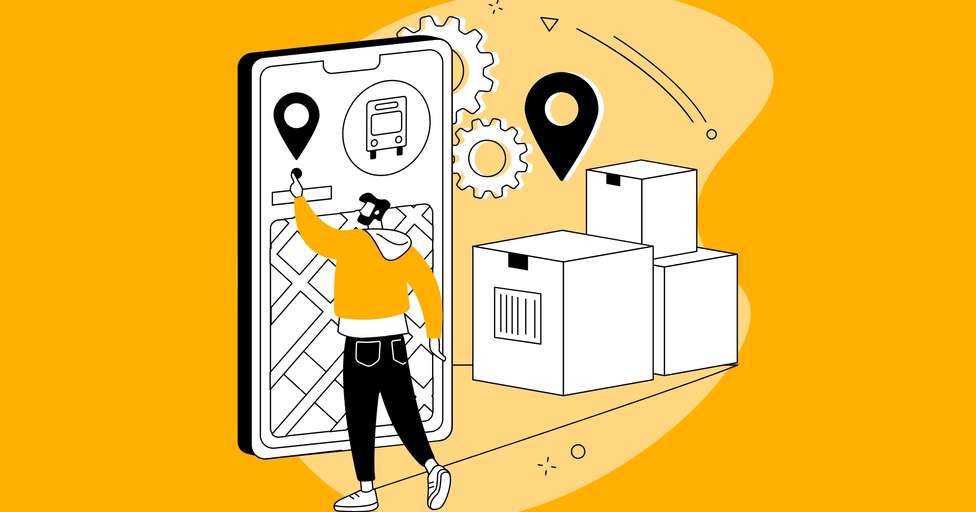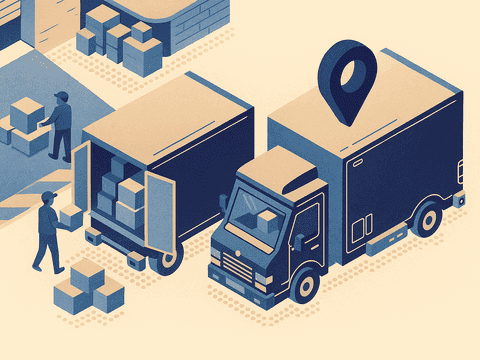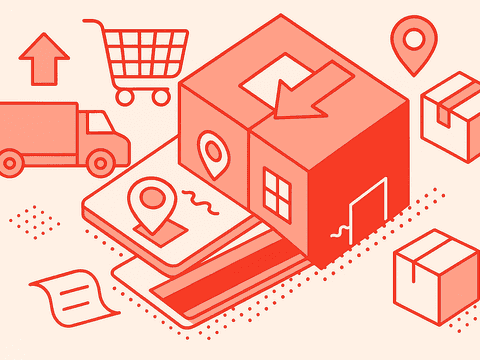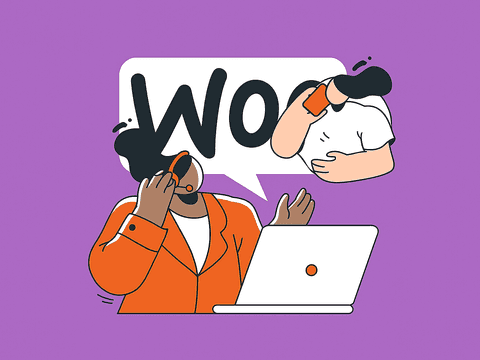TL,DR:
- Branded tracking pages boost engagement. Customers check tracking pages multiple times per order, making them ideal for upselling, loyalty-building, and reducing WISMO tickets with clear ETAs and visual timelines
- Customization drives conversion. The best tracking pages aren’t just informative—they're branded touchpoints that include dynamic messages, product carousels, and localized content to reflect your store’s identity
- Mobile-first design is a must. With most customers tracking on smartphones, your tracking page should be fast, responsive, and easy to navigate—especially for high-frequency repeat buyers
- Outvio turns tracking into a revenue tool. Outvio’s tracking page does more than show delivery status. It lets you cross-sell products, trigger returns, chat with shoppers, and automate post-purchase actions, all fully branded
Choosing the right branded tracking page for your eCommerce store isn’t easy. With so many tools on the market, it can be hard to figure out which one actually improves the post-purchase experience, and which ones just add complexity.
Many platforms provide basic tracking, but they lack the flexibility to support brand customization, upselling, or meaningful customer interaction.
First, we’ll break down what a branded tracking page should include, beyond just shipment updates. Then we’ll take a look at how most tracking solutions handle the customer journey after checkout.
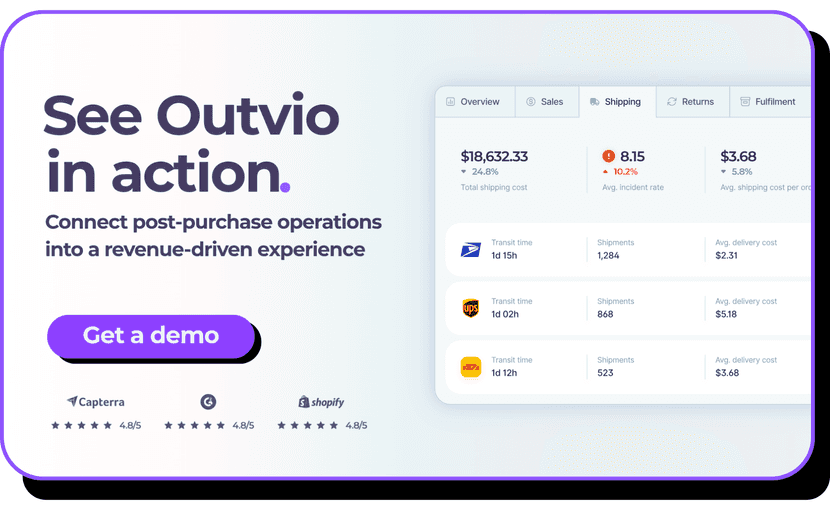
Why leading eCommerce brands insist on branded tracking pages
Customers remain highly engaged after clicking “Buy.” On average, they check their order status about 4.6 times per order—making tracking pages one of the most viewed customer touchpoints in eCommerce.
Forward-thinking brands are turning this attention into a strategic advantage. By replacing generic carrier tracking pages with fully branded ones, retailers keep customers within their ecosystem and strengthen brand loyalty.
Branded tracking pages also dramatically reduce support tickets, especially WISMO (“Where is my order?”) inquiries. By providing real-time status updates and clear ETAs in one place, top brands prevent customer confusion before it arises.
For example, Powerplanet Online—one of the largest tech eCommerce retailers in Europe—reduced their support workload by 60% using Outvio’s branded tracking page.
Key Features to Include in a personalized tracking page
A good branded tracking page should support your brand, enhance the customer experience, and create opportunities for engagement. Here are the essentials to look for:
- Custom domain: Let customers track orders from your own URL (e.g., tracking.yourstore.com) instead of a third-party site. This strengthens your brand and keeps traffic on your platform.
- Branded layout: Apply your logo, brand colors, fonts, and design elements to create a fully white-labeled experience.
- Real-time tracking widget: Embed a live tracking module that pulls updates directly from carriers. Show current location, latest scan, and estimated delivery date.
- Visual delivery timeline: Use a timeline or progress bar to represent each delivery stage clearly: confirmed, shipped, out for delivery, delivered.
- Product summary block: Show what the customer ordered—product images, names, SKUs, and quantities—along with shipping method and ETA.
- Mobile-first design: Ensure the page is fully responsive and optimized for mobile screens, with tap-friendly elements and fast loading.
- Personalized messaging: Display dynamic messages based on order status, customer segment, or product type (e.g., “Your exclusive item is on the way!”).
- Product recommendations carousel: Include AI-powered or rule-based suggestions to upsell or cross-sell relevant items based on the original purchase.
- Promotions banner: Highlight ongoing campaigns or discount codes, making the most of the high engagement of this page.
- Integrated support options: Include quick-access buttons for live chat, WhatsApp, help center, or contact forms.
- Review prompt module: Once the order is delivered, trigger a review request directly on the tracking page, or redirect to a feedback form.
- Social media CTA: Encourage customers to share their purchase or follow your brand with embedded social links or hashtags.
- Estimated delivery countdown: A real-time countdown (e.g., “Arriving in 2 days”) to build anticipation and set clear expectations.
- Multi-language support: Detect and display content in the customer’s preferred language to improve accessibility and clarity.
Top 7 branded tracking pages for 2025
1. Outvio
Outvio centralizes the entire post-purchase experience into one branded environment. Its tracking page is highly customizable and compatible with any carrier out of the box.
You can display personalized product suggestions, engage with customers via live chat or delivery notifications, and ensure that every update includes branded messaging. This makes it a powerful tool for brands looking to turn delivery into an extension of their storefront. Outvio also supports upselling, feedback collection, and automates WISMO reduction through real-time visibility and proactive communication.
This is what Outvio’s tracking page looks like:

As you can see in the image, you can display personalized product recommendations and time-sensitive offers, turning a passive delivery check into a new sales opportunity that increases AOV. It also lets customers take real-time actions on their order, such as editing delivery preferences, starting a return, or contacting support, without leaving the page.
Pros
- Combines tracking, support, marketing, and analytics in one tool
- Highly customizable and works with any carrier globally
- Enables real-time engagement through product suggestions and messaging
- Scales with your business
Cons
- May offer more features than needed for very small stores
- Full value comes with using multiple features together
2. Wonderment
Wonderment is built for proactive shipping communication. It connects with your fulfillment and carrier systems to detect delays or exceptions before customers even notice them. By sending automated alerts when something goes wrong, it helps reduce “where is my order” tickets.
Pros
- Strong at managing delivery delays and exceptions
- Helps reduce support tickets with early alerts
- Integrates well with help desks and ESPs
Cons
- Lacks customer-facing personalization features
- No built-in upsell or engagement tools
3. ShipStation
ShipStation includes a basic branded tracking page as part of its shipping platform. While customization is limited, it’s functional and easy to set up. It provides customers with real-time updates and delivery windows using a clean interface.
Pros
- Easy to activate if you're already using ShipStation
- Delivers reliable tracking with little effort
- Good for straightforward logistics needs
Cons
- Limited branding and customization
- No native marketing or feedback options
4. Sendcloud
Sendcloud simplifies the shipping process by offering label creation, carrier selection, and basic branded tracking features. It’s especially strong in Europe, with multi-carrier support that makes it easy to switch between providers. The branded tracking experience is simple but effective, making it a great solution for small to mid-sized online stores.
Pros
- Quick to set up with solid carrier options
- Useful for small to mid-sized EU stores
- Minimal technical setup required
Cons
- Basic tracking page functionality
- Doesn’t support marketing or help desk features
5. ParcelLab
ParcelLab offers advanced control over post-purchase communications. Brands can customize the content customers see depending on shipping region, delivery speed, or logistics status. With support for multiple languages and personalized messaging rules, it’s ideal for companies that need granular control across different markets.
Pros
- Excellent control over messaging by region or delivery status
- Strong enterprise-level features for global brands
- Supports multilingual workflows and advanced rules
Cons
- Requires time and effort to implement fully
- Best suited for large teams with technical resources
6. Clickpost
Clickpost is designed for logistics teams that need performance insights and automation. It provides shipment tracking along with detailed analytics on carrier performance. Brands can also automate delay alerts and other delivery-related messages. It’s a popular choice in Asia, particularly among businesses looking to improve operational efficiency in last-mile delivery.
Pros
- Great for analyzing carrier performance
- Useful for operational teams focused on logistics
- Automates shipping communication
Cons
- Not built for brand experience or customer engagement
- Limited customization and upsell capabilities
7. Route
Route stands out by combining package tracking with built-in buyer protection. Customers can view all their orders from different stores in one mobile app, while merchants benefit from reduced chargebacks on lost or damaged items. The mobile-first experience is highly visual and designed with the end-user in mind, making it ideal for brands that prioritize customer experience and peace of mind.
Pros
- Adds shipping protection for customer peace of mind
- Mobile-first tracking experience
- Appeals to customers ordering from multiple stores
Cons
- Puts branding second to the Route experience
- Less suitable for merchants wanting full control over tracking and messaging
How to fully customize tracking pages to match your brand style
1. Visual brand identity integration
Your tracking page should feel like a natural continuation of your website—not a generic third-party portal. Customization starts with key branding elements:
- Logo & Header Customization: Upload your logo and match the page header to your site’s navigation or brand tone.
- Color Scheme & Typography: Apply your brand’s specific colors, fonts, and button styles to create visual consistency.
- Favicon and Page Title: Small details like a custom favicon and branded page title reinforce professionalism and attention to detail.
2. Tailored customer messaging
Don’t waste the opportunity to communicate. Tracking pages are highly visited—many customers check them multiple times throughout the delivery process. That means:
- Dynamic Text Customization: Rewrite tracking statuses in your own brand voice. For example, “Out for delivery” could become “Your order’s on its way—almost there!”
- Personalized Banners & Content: Include messages like “Thanks for your purchase, Sarah!” or show exclusive promotions based on the order.
- Embedded Cross-Sells: Highlight related products based on purchase history or product category.
3. Layout & design flexibility
Customization goes beyond just logos and colors. Great platforms let you fully control the structure of your page:
- Modular Sections: Add, remove, or rearrange blocks like delivery status, product images, FAQs, or “You might also like” carousels.
- Theme Modes: Offer light or dark modes, depending on your brand's style or your customers' preferences.
- Multimedia Support: Incorporate promotional videos, lifestyle imagery, or tutorials that match your product niche.
4. Multilingual and international options
If your brand serves a global audience, language flexibility is a must:
- Auto Language Detection: Automatically adapt based on the customer’s browser language.
- Manual Language Selection: Provide a dropdown to switch languages and ensure clarity.
- Localized Text and Format: Adapt delivery date formats, currency signs, and wording based on location.
5. Control over information display
You decide what your customers see. This helps you balance transparency with simplicity:
- Hide Unnecessary Details: For example, hide carrier names or shipping origins if you work with multiple logistics partners.
- Show Only What Matters: Display estimated delivery dates, package status, or contact info based on relevance.
- Embed Social Proof: Add reviews or user-generated content to reinforce product satisfaction even after purchase.
6. Scalable templates for multi-brand or multi-store operations
If you operate different stores or sub-brands, customization is essential to keep branding consistent for each:
- Dedicated Templates per Store: Use unique layouts, colors, and content per store or region.
- Shared Elements: Maintain certain brand-wide assets like legal disclaimers, delivery terms, or loyalty program prompts.
Outvio, the best branded tracking page for eCommerce
Among the many tools available to improve the post-purchase experience, Outvio stands out for its ability to bring together branding, logistics, and customer communication in one place. It’s a practical solution for businesses that want to take full ownership of the post-purchase journey without adding complexity.
Offering the customer a static delivery experience is not enough. If you engage them with valuable communications, you can create a stream of repeat buyers. Outvio provides the functionality to do that.
Find out why Outvio is the best branded tracking page. Book a demo today.

